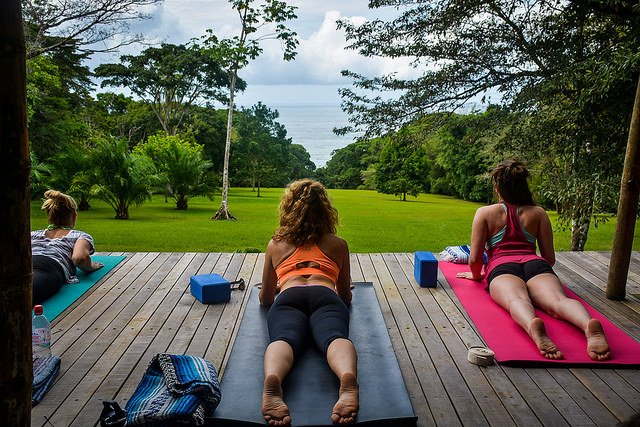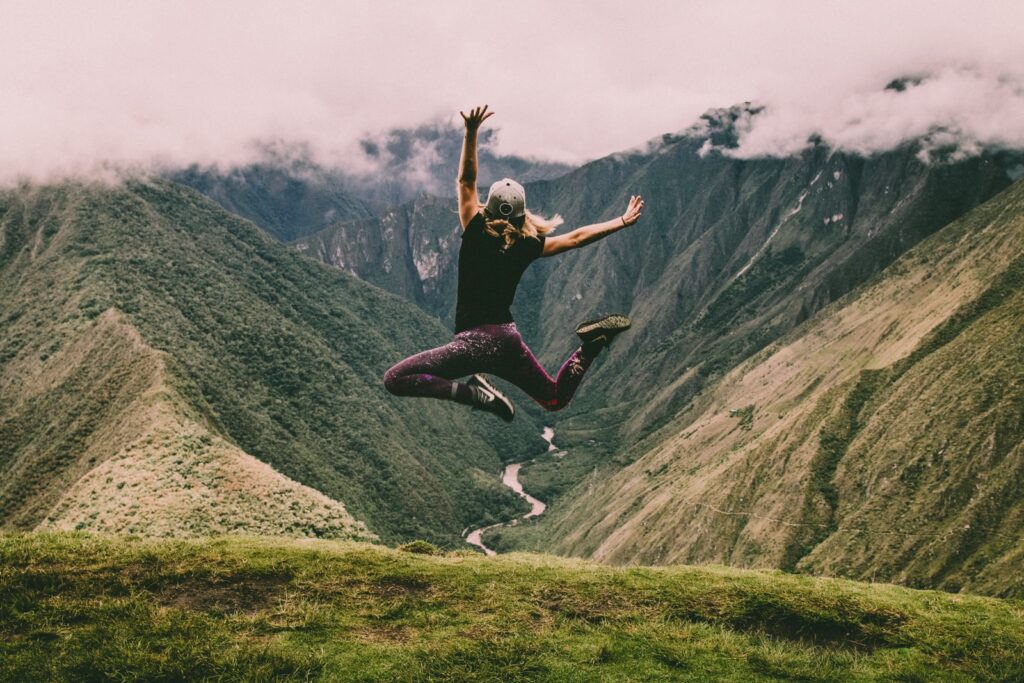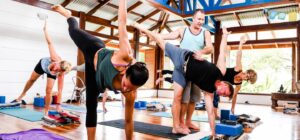“Yoga is not about flexibility.”
This phrase is something we often hear yoga teachers say. And then, they proceed to teach people how to go deeper into yoga poses.
Here is a typical example of what you often hear in a yoga class:
“We have to open the hips.”
I remember one teacher, who brought a yoga group to Blue Osa, proclaimed,
“Your hips are too closed. We have to open them if we ever want to do XXX posture.”
So here is a fact many yoga teachers REALLY need to hear.
There is no empirical evidence that shows that being more flexible makes you a happier person.
Nevertheless, if you go into any yoga class, all you hear about is flexibility. Perhaps the word flexibility is not used, but it is constantly insinuated.
While the yoga teacher may say that flexibility is not everything, their instructions and body language always speak their intention.
How often have I heard variations of this phrase?
“Do not worry about touching your toes. It is not about touching your toes. Even so, keep working on it. The practice will take you there.”
Many students are left wondering how they can achieve the state of yoga if they are not flexible. I know first hand because I have to do damage control in my yoga teacher trainings continuously.
Is Stretching Good For You?
Stretching will lead you to more pain.
Why?
Because flexibility inevitably leads to instability.
And where there is instability, injury is sure to follow.
From an Applied Yoga Anatomy + Muscle Activation™ perspective, people have no strength in their flexibility. At their furthest flexible point, muscle function is diminished or nonexistent.
And yes! We can test this! (As you will see below.)
The yoga world is obsessed with stretching, and it is a paradigm that needs to change.
Stretching is ultimately damaging more people than it is helping. Stretching does not help improve muscle function, and there is ample empirical evidence to show that stretching incapacitates muscle function.
What Is the Purpose and Function Of Muscle?
The #1 function of muscles is to move bones.
The degree to which those muscles move bones is called “range of motion.”
If I asked you to do a seated twist, you would instinctively rotate your body and then use your arms and hands to augment and “deepen” the twist. However, this is not testing the actual range of motion. You are just training your body to become hyper-flexible in rotation.
Wherever you are right now, do a simple test to see how much range of motion you have in your spinal rotators:
- bring your hands to the opposite shoulders.
- lock your hips by squeezing them to the midline.
- arch/extend your upper back as much as you can by lifting the chest.
- arch/extend your lumbar spine
- with your hips squeezed towards the midline, rotate your upper chest to the right, twisting from the naval.

- notice how far you can twist/rotate.
- now repeat to the left.
- notice if there was a difference in how much you could twist to one side versus the other.
How far you were able to twist has nothing to do with flexibility. How far you were able to rotate has everything to do with muscle function. Muscles move bones by contracting/shortening. Therefore, to rotate, muscles needed to contract. (One of the primary trunk rotators are the oblique muscles.)
How Much Stretching Can Be Harmful?
Stretching muscles is synonymous with forcing muscles to go beyond their capacity to lengthen or shorten.
Think about a simple pose called apanasana. (Knees to chest pose.)
If I ask you to lie on your back, with your arms out to the sides, and pull your knees to your chest.
How close were you able to get your knees to your chest?
The muscles responsible for doing that movement contracted/shortened to bring those knees into your chest. (Some of the key muscles that pulled those knees in are the psoas major and minor, pyramidalis, first rectus, rectus femoris.)
Now take your arms, wrap them around your knees and pull them further. Here, you are forcing those muscles to contract or shorten beyond their capacity. You are passively pushing your body beyond its muscular capacity. Biomechanically, you bypass the nervous system and force the body to do what it is not ready to do.
What happens next is that all the muscle shuts down. Anytime we passively shorten or lengthen a muscle, the brain’s neuropathways to the muscle are severed.
The muscle loses its ability to contact and contract on demand.
Can you repair the damage caused by overstretching?
Sure.
Yet, the longer you keep stretching and abusing your muscular system, the more effort it will take to repair it.
Then How Much Should You Stretch?
The short answer is never stretch.
Now for the longer answer.
According to Stephen Gangemi,
“The thought that stretching relaxes and is therapeutic for tight muscles is not only a misconception, it has never been proven. It actually weakens muscles… Muscle tightness is due to an imbalance. The imbalance lies within the neuromuscular system – so it is a reflection of the nervous system via the muscular system…”
“There is a neuromuscular inhibitory response to static stretching,” Malachy McHugh, the director of research at the Nicholas Institute of Sports Medicine and Athletic Trauma at Lenox Hill Hospital in New York City, told the New York Times. “The straining muscle becomes less responsive and stays weakened for up to 30 minutes after stretching, which is not how an athlete wants to begin a workout.”
What we need to focus on is getting muscles activated and then stronger. A strong activated muscle can withstand the stress that life puts upon it.
There have been too many instances where I have taken a yoga class, only to throw my back out.
After one teacher training just finished, I was in the shower preparing for graduation. As I was washing my hair, I reached my hand up to grab the shampoo bottle, only to tweak my rhomboid and levator scapular. I was left in severe pain that lasted for weeks.
As it happened, the day before, I demonstrated a yoga twist that had involved a bind. I had plenty of flexibility, but I had no stability.
Then What Is the Purpose Of Yoga Postures?
From an Applied Yoga Anatomy + Muscle Activation™ perspective, our goal is to improve muscle function.
In the video below, I demonstrate the power of muscle activation. We see an important muscle, the glute, not contracting. It has lost its ability to contract and contract on demand. (The glutes play a significant role in preventing lower back pain.)
Watch how much the muscle function improves once we activate the glutes. The result is mind-blowing. You have to see it to believe it. (Watch at least the first 12 minutes.)
A Stable Body Equal A PAIN-FREE and Stable Life
First foremost, please join me in a sincere effort to stop this flexibility madness. Even if you disagree with the facts, you are not teaching yoga by focusing on flexibility.
There is no mention anywhere in the yoga sutras or Hatha Pradipika on the importance of flexibility.
What these sacred texts teach us is the importance of breath and merging the mind with it.
One of my favorite quotes comes from BKS Iyengar who is one of the fathers of what we know of as yoga. BKS Iyengar said:
“Health is firmness in body, stability in mind and clarity in thinking”
Notice there is no mention of flexibility in this statement.
Again, there is NO MENTION of stretching or flexibility anywhere in the Yoga Sutras or Hatha Yoga Pradipika.
Second, if you feel inspired to learn more about Applied Yoga Anatomy + Muscle Activation™, watch the video above and take the class that follows the demonstration. Once you have finished the practice, notice how your body feels and how much more stability you have than when you started.

Thirdly, this is a specific message to all yoga teachers.
STOP demonstrating yoga postures to your students. Especially the yoga postures that offer opportunities for you to “show off yoru flexibility.” You are not benefiting your students. You are only satisfying your own ego. Put the needs of your own students first. And that starts with you teaching them yoga. Not showing them how flexible you are.
We, yoga practitioners, have enormous power and sway to affect the momentum of our students. We can choose to help our students become more flexible or empower them to become stable and resilient agents of change.
Take the next step and check out this simple and easy hack to get rid of your back pain.
About Yogi Aaron

Yogi Aaron is the owner, operator, and lead yoga facilitator at Blue Osa and of the yoga teacher trainings.
Creator of Applied Yoga Anatomy + Muscle Activation™ Yogi Aaron brings three decades’ worth of study, mentorship, and experience into his teachings, with a strong emphasis on yoga therapy and alignment.
The Muscle Activation Yoga Classes is an exploration into your body, its muscles, and to learn how to improve its function through using Applied Yoga Anatomy + Muscle Activation™.
Find out more about yoga teacher trainings with Yogi Aaron at Blue Osa Yoga Retreat + Spa.











